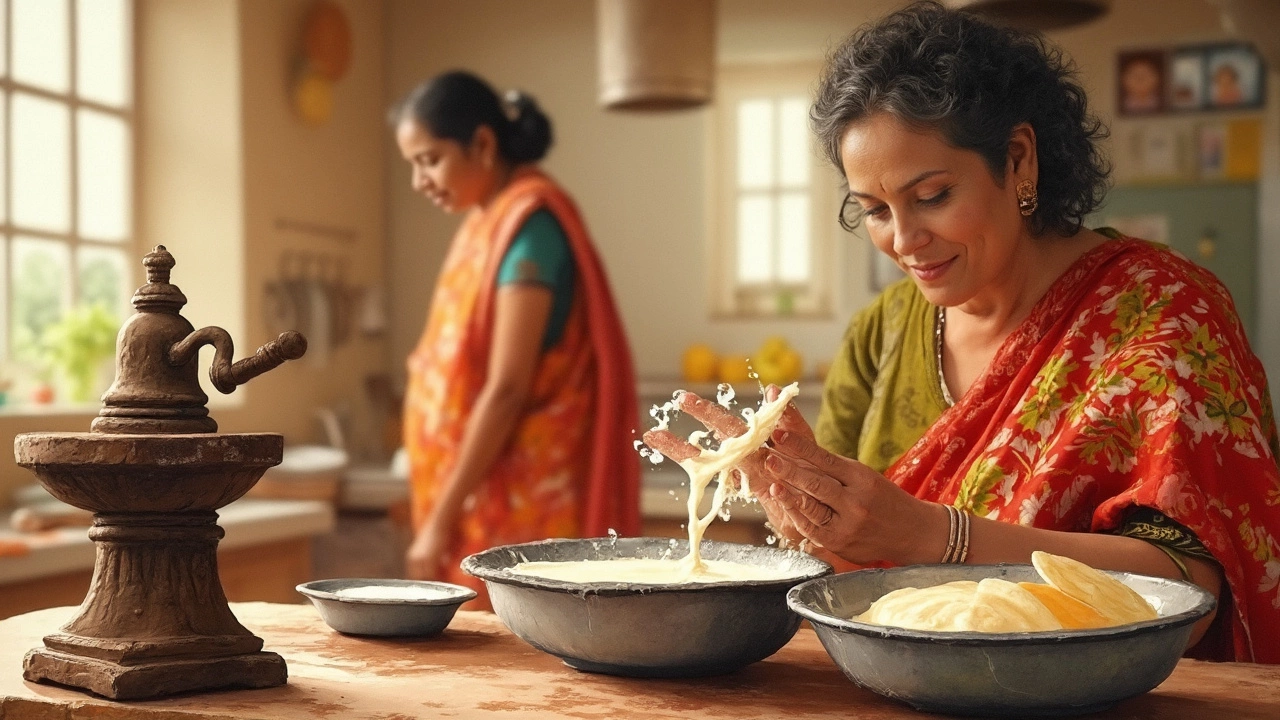Ever tasted a dosa that’s soft and fluffy in the middle but still crisp at the edges? There’s a good chance someone slipped a spoonful of curd into the batter. Curd, or plain yogurt, isn’t just for raita or side dishes—it can seriously change how your dosa batter behaves.
The biggest reason home cooks reach for curd is to help with fermentation. If your kitchen’s chilly or your batter just refuses to rise, curd acts like a fermentation booster. The natural bacteria in curd speed things up, giving you that lovely, slightly tangy flavor and bubble-packed batter even when weather isn’t on your side.
Some people worry about ruining the batter or making dosas taste weirdly sour. Here’s the thing: if you use the right type and right amount of curd, that won’t happen. Stick around and you’ll learn exactly how much to use and when to add it to get consistent results.
- Why People Add Curd to Dosa Batter
- How Curd Changes Fermentation and Texture
- Tips for Using Curd Without Ruining the Batter
- Troubleshooting: Common Curd-Batter Problems
- Quick Dosa Variations Using Curd
Why People Add Curd to Dosa Batter
Curd in dosa batter isn't just a grandma's hack—it's a lifesaver for anyone who struggles with fermentation, especially in cooler weather or when time is tight. The friendly bacteria in curd (lactobacillus) kick-start the fermentation process, helping your batter rise faster and develop that classic tangy kick we all love in a good dosa.
But speed isn’t the only reason. Curd does something special to the flavor and texture, too. It helps soften the dosa by breaking down proteins in rice and urad dal, so your dosas turn out fluffier and less leathery in the middle. If you're after softer dosa or have noticed your usual batter is dense, adding curd can be a total game-changer.
Here's why so many folks, from street vendors to home cooks, swear by this trick:
- Makes fermentation possible even when room temps are below 25°C (a real challenge in winter).
- Shortens fermentation: with curd, you can sometimes shave 2-3 hours off compared to plain batter.
- Adds subtle tangy flavor, which is that signature dosa taste you get in many South Indian restaurants.
- Can rescue a batter that just refuses to ferment well—even old batter wakes up with a little curd.
Check out this quick data snapshot comparing plain batter vs. batter with curd during winter:
| Batter Type | Fermentation Time (at 20°C) | Rise & Tang |
|---|---|---|
| Plain Batter | 12-16 hrs | Medium |
| Batter with Curd | 8-10 hrs | High |
So, when you need dosa batter recipe results without much waiting or fuss, curd is a safe bet. Plus, it’s easily available in most kitchens, so you’re not hunting for special ingredients.
How Curd Changes Fermentation and Texture
Adding curd in dosa batter isn’t just a tradition—it actually shifts the science of how your batter ferments and cooks. The natural lactic acid bacteria in curd (mainly Lactobacillus) jumpstart the fermentation process. Normally, dosa batter needs anywhere from 8 to 16 hours at room temperature to bubble up nicely. With curd in the mix, you’re speeding up microbial action. This comes in super handy during colder months or if your kitchen is air-conditioned and everything ferments slower than paint drying.
Curd also kicks up the tangy flavor you expect from classic dosa, without making things sharply sour (as long as you don’t dump in too much). The same bacteria break down the rice and urad dal in your batter, which makes the final dosas not just more flavorful but also lighter and softer. Think cloud-like rather than chewy or tough—especially great if you’re after softer dosa or want to avoid that rubbery edge you sometimes get from under-fermented batter.
Here’s a quick breakdown of how batter looks and feels with and without curd, based on home kitchen experiments:
| Batter Type | Fermentation Time | Texture Result | Flavor |
|---|---|---|---|
| Plain batter | 10-16 hours | Usually thin, may be grainy | Mild, not too tangy |
| Batter with curd | 6-8 hours | Smooth, slightly bubbly, softer | Tangy, more depth |
One thing to note—if you go overboard and add too much curd, the batter can become too acidic. That can lead to sour dosas that might not crisp up well, so stick to one or two tablespoons per kilo of soaked rice and dal mix. If you’re using dosa fermentation as your main reason to add curd, make sure your curd is fresh but not too runny or sticky. Watery curd can thin your batter down too much, throwing off the texture.
Bottom line: curd isn’t magic, but it’s a great tool if you want lighter, softer, more flavorful dosas—plus faster results, especially in a pinch. Just use it right, and your dosa batter recipe gets an instant boost!

Tips for Using Curd Without Ruining the Batter
Adding curd in dosa batter can make a huge difference, but you’ve got to do it right. Here’s the lowdown on how to get all the fermentation benefits without throwing off the taste or texture.
- Choose fresh, plain curd. Avoid flavored or sour curd—just regular, homemade or store-bought plain yogurt is perfect. Super-sour curd will overwhelm your batter, making the final dosas taste sharp.
- How much to add? The sweet spot is about 2 to 3 tablespoons of curd for every 2 cups of rice you soak. Too much can make the batter too runny and give the dosas a weird aftertaste.
- Add after soaking and grinding. Always mix curd into the ground dosa batter, not while the rice and dal are still soaking. This way, the curd jumpstarts the fermentation right when you leave the batter to rise.
- Mix it in well. To make sure the dosa batter ferments evenly, use your hand to mix, not a spoon. Your skin’s natural bacteria actually help the process along (it’s an old South Indian trick).
- Watch the weather. In hot weather, a little curd goes a long way: maybe even just 1 tablespoon. If it’s cold, go closer to the 3-tablespoon mark to give fermentation a real push.
- Don’t skip salt. Adding salt before fermentation slows down sourness a bit, keeping your dosa from turning extra tangy overnight.
Here’s a handy table as a quick reference for how much curd to add based on typical household batches:
| Dosa Batter (uncooked rice + dal) | Curd Quantity | Weather |
|---|---|---|
| 2 cups (serves 4-5) | 2 tbsp (summer) 3 tbsp (winter) |
Adjust for warm vs. chilly kitchens |
| 4 cups (big batch) | 4 tbsp (summer) 6 tbsp (winter) |
Err on the low side if room is hot |
If you follow these tips, you’ll get softer, tastier dosas with just enough tang. No weird aftertaste. No sticky, over-soured disasters. And if you ever mess up? Just reduce the curd next time—the batter is forgiving if you don’t go overboard.
Troubleshooting: Common Curd-Batter Problems
Using curd in dosa batter can be a game changer, but sometimes things go sideways. Maybe your batter smells too sour, the dosas come out too thick, or ferments unevenly. Let’s break down what can go wrong and how to fix it fast.
Problem 1: Batter Too Sour
If your dosa tastes almost like vinegar or a tangy cheese, you might’ve put in too much curd or left the batter out too long. Fermentation speeds up with curd, especially in warm weather. Try these fixes:
- Use only 1-2 tablespoons of fresh, plain curd per 2 cups batter.
- Skip curd if your kitchen’s over 28°C (82°F)—natural fermentation will happen super fast anyway.
- If batter gets too sour, mix in a bit of rice flour and a pinch of salt before cooking, and use it up quickly.
Problem 2: No Rise or Fermentation
Sometimes, even with curd, the batter just sits there looking sad and flat. This usually means your curd wasn’t fresh, or the ratio wasn’t enough to boost the process. Here’s how to react:
- Check if your curd has that slightly tangy smell—old or dead curd won’t help.
- Warm up your kitchen: Place the batter in the oven with the light on, or wrap it in a kitchen towel.
- Try adding a pinch of sugar to give the bacteria a nudge.
Problem 3: Dosas Are Too Thick or Chewy
This usually means you’ve gone overboard with curd or skipped enough resting time for the batter. To fix:
- Thin out the batter with water—aim for pancake-batter consistency.
- Let the batter rest for at least 30 minutes after adding curd to let fermentation settle down.
- For crispier dosas, sprinkle some dosa batter recipe rice flour into the mix and give it a good stir.
If you’re dealing with repeated issues, here's a quick reference table:
| Problem | Common Cause | Quick Fix |
|---|---|---|
| Batter too sour | Too much curd or long fermentation | Add rice flour and cook soon |
| No fermentation | Old or cold curd, cold room | Use fresh curd, warm up environment |
| Dosas too thick | Excess curd, batter too thick | Thin with water, add rice flour |
Don’t get discouraged—getting the right curd in dosa batter rhythm takes a little practice. Even pro chefs have batter fails now and then. Once you nail these common hurdles, you’ll have softer, tangier, and more reliable dosas every time.

Quick Dosa Variations Using Curd
If you want to shake up your regular dosai routine, adding curd in dosa batter can open up a bunch of tasty shortcuts and new textures. When you're pressed for time or missing the ideal warm weather for fermentation, curd is your best friend for quick and flavorful results.
- Set Dosa: Famous in Karnataka, this variation is all about thick, soft, spongy dosai. Mixing a bit more curd than usual into the batter lets you skip some fermentation time and gets those signature bubbles quickly.
- Instant Dosa: Got leftover rice or old idli/dosa batter that looks flat? Blend it with curd, rice flour, and a pinch of baking soda. You’ll get crispier results without waiting overnight.
- Curd Dosa (Thair Dosa): This one's a gamechanger when you’ve run out of fresh batter. Mix rice flour, curd, water, and salt. No grinding or soaking needed. Wait 15-20 minutes, pour it on the pan, and you’re done.
Here’s a real-world tip: the more curd you add, the tangier your dosa will taste. If you’re aiming for a mild flavor, stick to a couple of tablespoons for every two cups of batter. Want a strong fermented kick? Bump it up to a quarter cup but watch your salt levels—it intensifies with more fermentation.
How does curd affect crispiness? It mostly softens the dosa, but you can increase the heat and add a shallow drizzle of oil to chase those golden, crispy edges. The balance of dosa fermentation and crispiness depends on your pan and oil too.
| Dosa Type | Curd Amount | Texture | Fermentation Time |
|---|---|---|---|
| Set Dosa | 1/4 cup per 2 cups batter | Thick, soft | 3-4 hours |
| Instant Dosa | 3-4 Tbsp per 2 cups | Thin, slightly crisp | 20-30 min |
| Curd Dosa | 1/2 cup per 2 cups rice flour | Soft, spongy | 15-20 min |
If you mess up and add too much curd, don’t toss the batter. Mix in a tablespoon or two of rice flour and let it sit for a bit. This helps thicken runny mix and keeps it from sticking. With these quick tweaks, adding curd in dosa batter is less about tradition and more about adapting to your kitchen’s needs—without sacrificing taste or texture.
